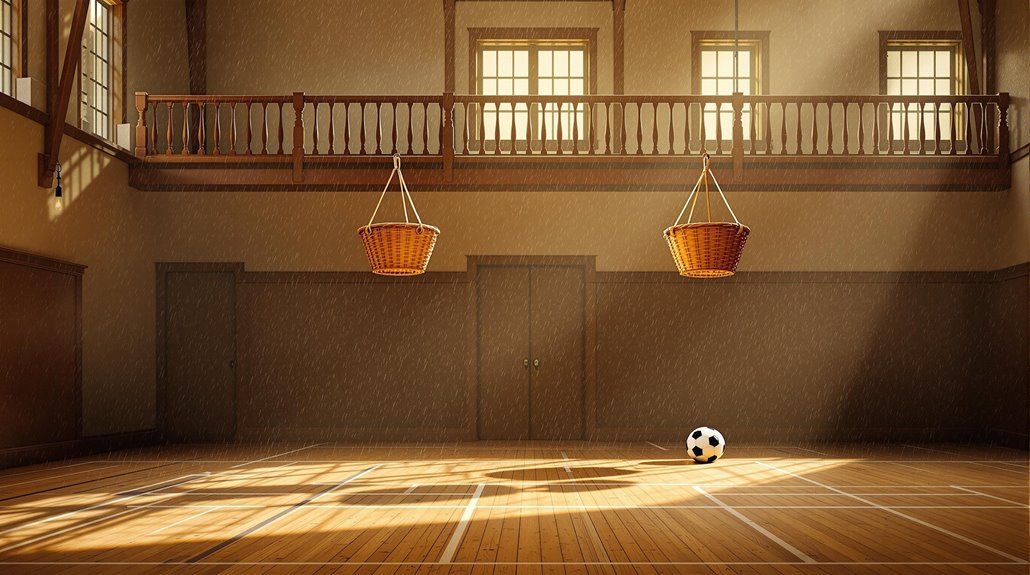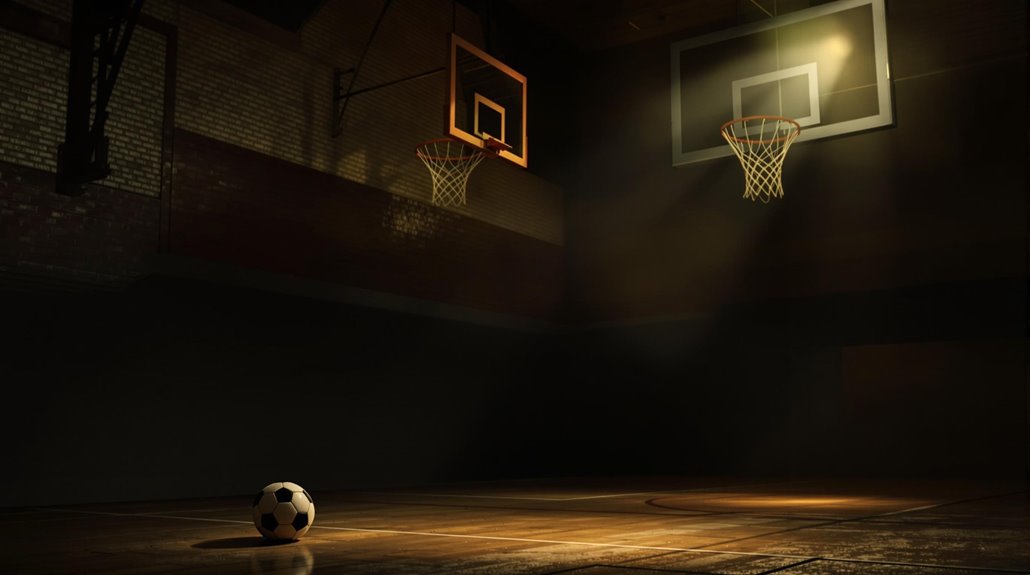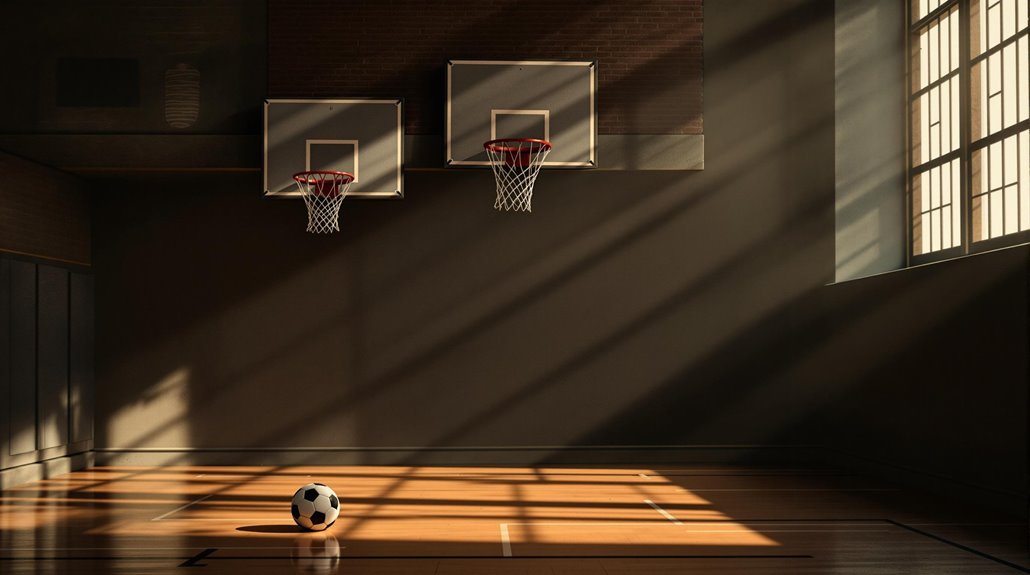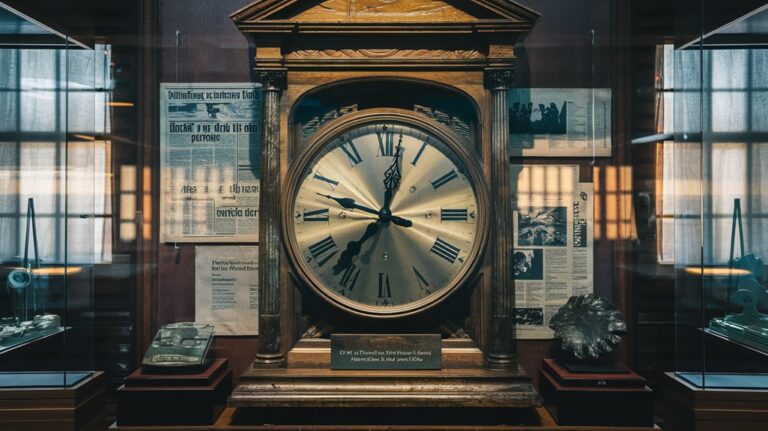James Naismith’s Peach Basket Debut: The Rainy Day That Invented Basketball
You've likely tossed a basketball through a hoop countless times, but have you ever wondered why the standard height is exactly 10 feet? On a stormy December day in 1891, Dr. James Naismith faced a simple yet challenging task: create an indoor game to keep his restless students active during harsh New England winters. His solution, involving two peach baskets and a soccer ball, would spark a global revolution in sports. The story behind this rainy-day invention holds more surprises than you'd expect.
The YMCA Challenge: a Game Born From Winter's Confinement

During the harsh New England winter of 1891, the Springfield YMCA faced a pressing challenge: how to keep energetic young men engaged between outdoor sports seasons.
The restless students needed an outlet for their pent-up energy, and existing winter activities weren't cutting it.
Enter Dr. Luther Gulick, who recognized the need for YMCA innovation. He tasked physical education instructor James Naismith with creating a new indoor game – and gave him just 14 days to do it.
Initial attempts to modify more traditional games like soccer and football failed to capture the students' interest.
A young graduate student at Springfield College, Naismith believed the problem lay with the system rather than with the students themselves.
The challenge was clear: design an activity that would keep a rowdy group of boys occupied while confined indoors. Naismith had to think creatively to develop something that would channel their energy productively.
This urgent need for winter activities would soon lead to one of the most significant sporting innovations in history.
From Duck on a Rock to History: Naismith's Creative Spark
When searching for inspiration, James Naismith drew from an unlikely source – a childhood game called "Duck on a Rock" that he'd played behind an Ontario blacksmith's shop.
These Duck Origins proved vital as he transformed a simple throwing game into what we understand as basketball today.
The Game Evolution from rock-throwing to basketball incorporated key elements from Naismith's youth:
- Players couldn't run with the ball, just as they couldn't move while throwing at the rock
- Goals were placed high up, similar to how the "duck" sat elevated on its base
- The art of the lob shot translated directly to shooting baskets
- Non-violent gameplay remained central to both activities
You'll notice how Naismith's creative adaptation turned a simple childhood pastime into a revolutionary indoor sport that would captivate millions worldwide. The game initially started with nine players on each team before evolving to its modern format. After much experimentation at the YMCA Training School, Naismith finally unveiled his creation in December 1891.
Setting the Scene: Springfield's Historic First Game
On a stormy December afternoon in 1891, James Naismith gathered 18 enthusiastic students in Springfield College's gymnasium to test his newly invented game.
You can picture the scene: peach baskets nailed 10 feet high at opposite ends, wooden ladders propped nearby, and a soccer ball ready for play. This indoor innovation was born from necessity, as New England's harsh winter weather had forced athletes inside. Initial games led to student roughhousing in the hallways before Naismith devised his solution.
The historic match proved remarkably simple yet engaging. As you'd imagine that first game, you'd see nine players on each side maneuvering Naismith's 13 basic rules. The game was specifically designed as a less injury-prone alternative to football.
William R. Chase etched his name into basketball's history books by scoring the only point in the 1-0 contest. The game's historical significance became immediately apparent as students embraced this new winter activity, setting the stage for basketball's eventual global impact.
The Original 13 Rules That Changed Sports Forever
The thirteen rules penned by James Naismith laid the groundwork for basketball's enduring success. His game strategy emphasized skill over strength, creating a sport that would captivate players and spectators alike.
As you explore the rule evolution, you'll discover how these guidelines transformed indoor recreation during harsh New England winters. The umpire judged players and maintained order throughout each match. The first manuscript of these rules is proudly displayed at Kansas, where Naismith later coached.
- Players couldn't run with the ball, forcing strategic passing and movement
- Physical contact was strictly forbidden, promoting finesse over force
- Goals counted when the ball remained in the peach basket
- Teams of nine players competed in two 15-minute halves
While some elements have changed dramatically – like the switch from peach baskets to iron hoops in 1913 – Naismith's core principles remain intact.
Today, these original rules, worth $4.3 million, showcase how a simple set of guidelines revolutionized sports forever.
Peach Baskets and Soccer Balls: Humble Beginnings

Basketball's earliest days showcase an ingenious use of everyday items. You'd barely recognize the sport if you stepped into that first game in 1891, where peach baskets hung 10 feet high on balcony railings and players tossed around a soccer ball.
Every time someone scored, someone had to climb a stepladder to retrieve the ball from the intact basket. The setup was far from perfect, but it served its purpose. Dribbling was not allowed until Yale basketball players discovered there was no rule against it in 1897.
With winter weather forcing athletes indoors, Naismith needed a game that would keep players active while minimizing physical contact. Drawing inspiration from sports like rugby and soccer, plus his childhood game "duck on a rock," he created a skill-based activity that would revolutionize indoor sports. The first official game was played with nine per team, setting a standard that would later evolve.
The original equipment may have been basic, but it laid the foundation for today's global phenomenon.
Beyond the Gymnasium: Basketball's Rapid Rise to Fame
While James Naismith's original sport remained confined to a small gymnasium in Springfield, Massachusetts, its explosive growth would soon transcend all expectations.
Through global outreach and cultural exchange, basketball transformed from a simple indoor activity into an international phenomenon.
Naismith established the game's official rules in January 1892, providing a clear framework for its widespread adoption.
You'll find basketball's meteoric rise reflected in these key developments:
- Springfield College's international students spreading the game to their home countries
- The sport's minimal equipment needs making it accessible worldwide
- The 1992 Dream Team showcasing basketball's highest level of play
- Technology enabling isolated nations to study and embrace the professional game
American soldiers stationed overseas during World War II helped spread basketball globally through Red Cross games organized to maintain troop morale.











